
by DGR News Service | Dec 5, 2021 | Direct Action, Human Supremacy, Mining & Drilling, Property & Material Destruction, Repression at Home, The Problem: Civilization, The Solution: Resistance
Sentenced to eight years in prison for acts of sabotage, water protector Jessica Reznicek reflects on her faith-driven resistance.
By Cristina Yurena Zerr
This article was first published in the German newspaper taz, and has been translated and edited for Waging Nonviolence.
On June 28, the federal court in Des Moines, Iowa was silent and filled to capacity. Fifty people were there to witness the sentencing of 40-year old Jessica Reznicek, charged with “conspiracy to damage an energy production facility” and “malicious use of fire.” The prosecution, asking for an extended sentence, argued that Reznicek’s acts could be classified as domestic terrorism.
This was not the first time Reznicek had been on trial, but this time she was facing a prison sentence of up to 20 years.
Sitting across from her was U.S. District Court Judge Rebecca Goodgame Ebinger, the prosecutor and an FBI agent. Numerous police officers in bulletproof vests stood around the courtroom. The defendant was called upon to give her closing speech.
In her loud, clear voice, Reznicek told them about her strong connection to the water. In her childhood she regularly went to the river to swim and play. But that’s no longer possible, she said, because the two rivers that run through Des Moines — Iowa’s capital — are now poisoned by agrobusiness pesticides and waste.
It was for these very personal reasons that she decided to fight the construction of the Dakota Access Pipeline, Reznicek told those in attendance. At least eight leaks, she explained, had already occurred in 2017, with 20,983 gallons of crude oil leeching into soils and the waterways. “I was acting out of desperation,” she said, describing her motivations for sabotage.
“Indigenous tradition teaches us that water is life. Scripture teaches that in the beginning, God created the waters and the earth and that it was good.” With these words, she ended her closing argument. The prison sentence followed shortly thereafter: eight years in federal prison, three years of probation, and a restitution of $3,198,512.70 to the corporation Energy Transfer.
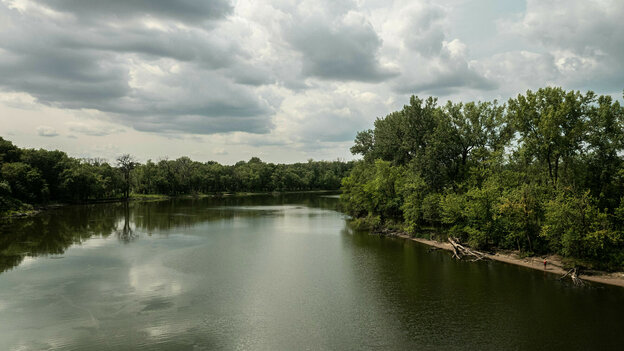
The Des Moines River (Cristina Yurena Zerr)
On July 24, 2017 — two years before sentencing — Jessica Reznicek can be seen in a shaky video with her activist partner Ruby Montoya, a former elementary school teacher who was 27 at the time. They stand in front of a group of journalists next to a busy street. The speech they give would drastically change their lives.
After several months of secretly sabotaging one of the country’s most controversial construction projects, the two women, whose paths would later part, went public. “We acted for our children because the world they inherit does not meet their needs. There are over five major bodies of water here in Iowa, and none of them are clean. After having explored and exhausted all avenues of process, including attending public hearings, gathering signatures for valid requests for environmental impact statements, participating in civil disobedience, hunger strikes, marches and rallies, boycotts and encampments, we saw the clear refusal of our government to hear the people’s demands.”
That’s why Reznicek and Montoya burned five machines at a pipeline construction site in Iowa on election night in November 2016. They would later change their methods, using a welding torch to dismantle the pipeline’s surface-mounted steel valves, delaying construction by weeks. “After the success of this peaceful action, we began to use this tactic up and down the pipeline, throughout Iowa,” the two women say.
But no media reported on their activities; the corporation cited other — false — reasons for the delay. When the activists noticed during an action that oil was already flowing in the pipes, they decided to go public, as they had to admit a kind of defeat.
The two women appear clear and determined on this day in the summer of 2017 as they take turns reciting their pre-written text. “If there are any regrets, it is that we did not act enough.” They end their speeches and are led away in handcuffs by three police officers.
Using the slogan “Mni wiconi,” meaning “Water is Life,” in the Lakota (Sioux) language, a broad movement was organized in 2016 against the construction of the Dakota Access Pipeline. The protest of the Standing Rock Sioux tribe garnered national and international attention.
The tribe sees the construction of the pipeline as a threat to their water supply because the pipeline runs under Lake Oahe, which is near the reservation. Other bodies of water are also at risk because the pipeline crosses under rivers and lakes in many places, which could contaminate the drinking water of many people in the event of an accident. In addition, ancient burial sites and sacred places of great cultural value would be threatened by the construction. Opponents of the pipeline speak of ecological racism — not only because Indigenous rights to self-government would be curtailed, but also because the construction of so-called Man Camps (temporary container cities for construction workers who move from other states) would lead to prostitution and an increase in violence against Indigenous women.
Their government — the Sioux Tribe is a sovereign nation — issued a resolution back in 2015 saying the pipeline “poses a serious risk to the very survival of our tribe and […] would destroy valuable cultural resources.” Construction would also break the Fort Laramie Treaty, which guarantees them the “undisturbed use and occupation” of reservation land. But their arguments went unheard by both the company and the government.
The operating company said the pipeline would not harm the environment, would not affect Indigenous rights and would not pose a threat to drinking water supplies. But the protest, which stretches across several states along the pipeline, has developed into one of the largest environmental movements in the United States. Native Americans from different nations and reservations are joining, along with landowners, environmental organizations and left-wing autonomous movements.
Reznicek first heard about the pipeline when she was released from prison six years ago, after serving a two-month stint for her protest against a U.S. military weapons contractor in Omaha, Nebraska. An organizer from Standing Rock had come to Des Moines to mobilize people for the protest. “I decided that I wanted to learn more about Indigenous ceremony, understanding that I am a white person, I cannot just go in and express my demands. And I also wanted to focus on stopping the Dakota Access Pipeline Project. So I drove up to Standing Rock.”
Where it all began
On a road on the outskirts of Des Moines — a city home to numerous insurance companies — large trees tower above the wooden row houses, providing shade on a hot July day.
Above the porch of one of the houses hangs a small sign that reads “Catholic Worker House.” In front of the back part of the building are tables and benches with people sitting on them. Music is playing, people are singing, someone is asleep on a bench.
In the kitchen of the house, Jessica Reznicek stands in front of the stove and slices five chicken breasts, freeing the meat from the bones. Next to them is a large pot of mashed potatoes, into which she generously spreads butter. “Our guests love butter,” Reznicek laughs. The kitchen looks as if many meals have been cooked there. Posters with anti-war messages and protest slogans are hung around the small room. On the windowsill in front of Reznicek is a statue of a bishop with a rosary around his neck.
Twice a week, Jessica Reznicek cooks for the homeless guests who come here. Usually they eat together in the living room, but since the outbreak of the coronavirus pandemic, the food is distributed through the window.
“I like the days when I’m in charge of the kitchen. It takes my mind off all the things that are going on in my head,” Reznicek says as she begins washing a mountain of dishes.
Two years have passed since her protests were made public. A year ago, Jessica Reznicek moved back into the community, spending time there on house arrest. Here, where it all began, her long journey ends. She has one week left before needing to report to prison.
Just before the food is served, the kitchen and living room fill up. Two of Reznicek’s friends are there, residents of the house and volunteers from outside — together they begin to serve food to the guests.
Reznicek has been in and out of the house for 10 years. Most people know her story: “The one who blew up the pipeline?” asks Jimmy — one of the homeless guests — laughing as he tastes the still-warm mashed potatoes. The fact that she will soon be gone saddens many of the residents. For the majority of them, prison is a familiar place. But no one here has been incarcerated as long as Jessica Reznicek will be.
The Dingman House, named after a late bishop in Des Moines, is one of four side-by-side buildings of the Catholic Worker community. Christianity and anarchism meet here. In these self-organized “houses of hospitality,” which function independently of the church, people live and work among the poor in the spirit of the Sermon on the Mount. The Christian message of social justice and solidarity with the marginalized becomes everyday practice. There is not much overlap with the institutional Catholic Church. In the bathroom, where homeless guests can shower, there are free condoms; trans people find shelter here and women sometimes lead church services.
Preparations for prison
The Berrigan House across the street — named after two priests who became known for their actions of civil disobedience against the Vietnam War — has always been a place of resistance, where protest actions are planned and activists find shelter. This is where Reznicek prepared her actions against the pipeline.
As in the house next door, the walls are covered with posters calling for resistance against war, racism and injustice. It is a colorful, chaotic and untidy atmosphere. Reznicek and her friends Alex and Monty sit at the table in the living room. The two are among her closest supporters. They just had a video conversation with Reznicek’s lawyer to discuss the final steps before she goes to jail.
A month after Reznicek is sentenced to eight years in prison, they launched a campaign called “Water Defenders Are Never Terrorists.” Within a few weeks, they were able to collect thousands of signatures. Their goal: a petition to President Joe Biden and Congress demanding the terrorism charges be dropped.
The list of things to do before Reznicek goes to prison is long: return the electronic ankle bracelet, pick up the copy of her high school transcript she needs so she won’t have to attend classes in jail. T-shirts demanding her release are to be printed. Reznicek also wants to develop photos that Alex will later send to her in prison so she can decorate her cell with them. But they also want to see her favorite musical Rent, go dancing one more time, invite friends and celebrate. There is a lot of laughter when the three get together.

Jessica Reznicek’s supporters Monty and Alex in the Christian Berrigan House. (Cristina Yurena Zerr)
After the meeting, Jessica Reznicek packs a vacuum cleaner and cleaning supplies and heads out. With permission from her probation officer, she started cleaning private homes a year ago. She also worked at a pizzeria from time to time.
Why is Jessica Reznicek willing to spend eight years of her life in prison because of her commitment to clean water? She was studying political science in Des Moines and married when she learned about the Occupy Wall Street movement in 2011. Shortly after, she decided to go to New York for the protests. This meant the end of her marriage. From the East Coast, she began a new life of sorts, always on the move, searching for a way to make her contribution to a more just world.
Reznicek traveled twice to Palestine and Israel, where she was deported for protesting in solidarity with the Palestinian people. She visited the Zapatistas in Mexico and spent time in Central America with the Indigenous people of Guatemala. In South Korea, she protested the construction of a U.S. Navy base. “So I feel like all of these experiences culminated at this point in my life when I heard about the Dakota Access Pipeline.”
The Catholic Worker community in Des Moines was central to her politicization. She stumbled upon the organization after returning to Iowa from New York. There begins what she later calls a conversion: a return to the Christian faith and her Catholic roots. At the same time, this means a radicalization in the struggle against injustice: Jesus Christ is seen Catholic Workers as a revolutionary who stood up for the disenfranchised, for the weak and the poor. He wanted to drive the kings from their thrones and bring justice. And he died on the cross without resisting his judgement.
Three months after Jessica Reznicek made her actions public in 2017, the Berrigan home was surrounded by the FBI. “It was like 4:30 in the morning when they were pounding on the door. The house was actually shaking. I ran downstairs and could see around 50 agents through the window with big guns and vests.”
When she opened the door, the house was stormed by about 50 uniforms. She was thrown to the ground and held at gunpoint, she said.
She then spent a year in hiding, calling it her wanderings. “I wasn’t necessarily underground. I think that I was running and I was hiding, but it was not exclusively from the federal government. I was not hiding from prison. I was hiding from everything.”
When she broke down after 10 months in Colorado, she finally realized she needed help. It won’t come from people or places, Reznicek says, but from her relationship with God. After this experience, she realized she wanted to live in a place where she could encounter God, so she decided to enter a Benedictine convent as a novice. But no sooner does she arrive than Reznicek is again picked up by the FBI and charged. They send her back to Des Moines — to the Berrigan home — to await the verdict under house arrest.
For the last four days before she goes to prison, Jessica Reznicek was given permission to visit the sisters at the convent community in Duluth. After her incarceration, she would like to move there or — if that’s not possible — live as close to the convent as she can.
On August 11th, Benedictine sisters drove Jessica Reznicek to the women’s prison in Wascea, Minnesota, four hours away. There, 714 women currently live behind the walls and fences.
Three hundred miles to the north is the town of Bemidji, home of Energy Transfer, the energy company to which Reznicek will be in debt for the rest of her life. A new pipeline called Line 3 has been under construction at this location for several years. As with the Dakota Access Pipeline, the region’s Indigenous inhabitants — the Anishinaabe and Ojibwe tribes — will be most affected by the project.
“Today I feel sad to be saying my final goodbyes to loved ones,” Reznicek said. “I am strengthened, however, knowing that I’m still standing with integrity during this very important moment in history, as there truly is no other place to be standing at a time like this.”
With these words she takes leave of her friends and turns to face the prison gates.
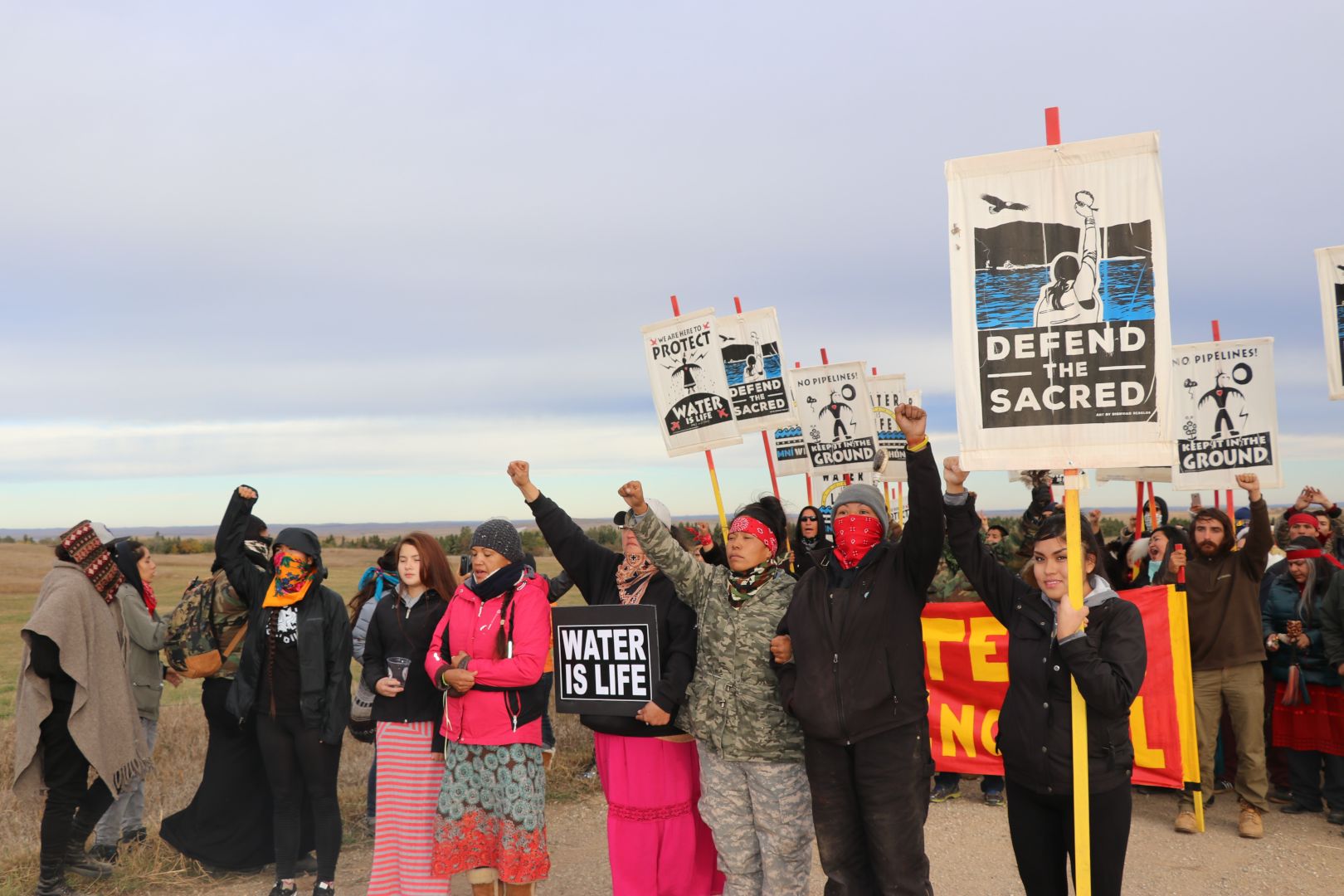
by DGR News Service | Sep 23, 2021 | Biodiversity & Habitat Destruction, Climate Change, Colonialism & Conquest, Direct Action, Indigenous Autonomy, Mining & Drilling, Movement Building & Support, Repression at Home, Toxification
This article originally appeared in Resilience.
Editor’s note: In order for the planet to survive, we must act in its defense. We can not rely on governments or corporations to do it. This is why Deep Green Resistance is organizing actions to confront the power structures—patriarchy, capitalism, colonialism, and civilization—largely responsible for the plunder of land and people.
By Alan Jay Richard
This is a story of victory for the earth and of the end of the Keystone XL pipeline. It also involves the Dakota Access pipeline and the Standing Rock Lakota reservation, indeed the entire world, all of which is threatened by our desperate last burst of fossil fuel exploitation. It is a story of what the dogged persistence and creativity of indigenous people and their allies can do against the kind of power we’ve been told is impossible to resist. But it’s a story without a guaranteed ending. The ending depends on us.
In 2004, small indigenous nations living near the Alberta Tar Sands project, the largest unconventional oil extraction effort in the world, began reaching out for help. Not only was the project interfering with their water, fishing, and hunting infrastructure, but rare and unusual cancers were appearing. They contacted policy experts at the National Resources Defense Council (NRDC) in Washington, D.C., who met with them in 2005 and saw photographic documentation of the devastation. These experts began to gather data and to raise awareness in the United States, on whose special refineries the project relied. Experts focused on the unique risks posed by tar sands at every stage of production, including extraction, transportation, and refinement. It wasn’t enough, but without the testimony and photographs supplied by indigenous people, experts would not have noticed for some time.
In 2008, approximately two dozen people from indigenous nations and environmental activist groups met to develop an overall strategy. The groups decided that the most promising activist target was the Keystone XL (KXL) pipeline, proposed by the giant TransCanada (now TC Energy) corporation to move the tar sands to refineries on the Texas Gulf Coast. Stopping the pipeline would rob the Tar Sands project of financial justification. The unusually expensive techniques required for extracting, transporting, and refining tar sands made them unusable when the global barrel price was low, and any increases in the cost of production would make investors flee.
This small group of people had almost no support. Going up against the Keystone XL pipeline meant taking on the Republican Party, half the Democratic Party, the U.S. government, the Canadian government, and the entire oil industry. But with the presence of indigenous organizers in this group, they soon discovered they had something far more important.
Attendees at the meeting began spreading the word. Clayton Thomas-Muller, a climate activist belonging to the Columb Cree Nation of Manitoba and an attendee, noticed that the pipeline would be running through the Oglala aquifer, a route that, in addition to being an environmental scourge, also threatened indigenous sovereignty. He began using his existing connections from previous anti-pipeline campaigns in indigenous nations to persuade tribal councils to pass resolutions opposing KXL, which they took directly to President Obama in 2011. He continued to work on tribal organizing throughout the effort to stop KXL. By 2010, Jane Kleeb of Bold Nebraska became aware of the Keystone XL threat. She attended the first State Department hearing on the pipeline in York, Nebraska in May out of curiosity without even knowing what tar sands were. At the hearing, she noticed that over 100 farmers and ranchers spoke out individually against the pipeline project and the only person speaking for it represented a union of construction workers on the pipeline. Kleeb thought the pipeline could be stopped if she could persuade Nebraska’s increasingly resistant farmers and ranchers to join indigenous people and environmentalists. To do this, she relied on indigenous support, including Muller’s. As a result, 150 tribes from the United States and Canada met in her state to sign an agreement opposing pipeline construction. The indigenous people she worked with also gave her good organizing and spiritual advice. First, stay rooted in real, concrete stories, not abstract principles. Second, never give up. The latter was remarkable guidance, especially coming from people who have endured what indigenous people in North America have endured.
The pipeline rose to national awareness in 2011, when former NASA climate scientist James Hansen wrote an essay arguing that it would be “game over for the climate” if the Alberta tar sands were fully developed. After this, 350.org got involved. They arranged for scores of celebrities to engage in civil disobedience in front of the White House. Here in Texas, Cindy Spoon, a graduate student at the University of North Texas, co-founded the Tar Sands Blockade after the White House protests and, following Kleeb’s lead, began organizing local pipeline resistance in communities along the Texas portion of the planned route. The Tar Sands Blockade, and the Great Plains Tar Sands Resistance that grew out of it, used bold, theatrical, and courageous tactics to block construction of the pipeline. Cindy also followed the guidance Kleeb had received from indigenous people in Nebraska, to stay rooted in stories and never give up. Tar Sands Blockade kept the issue in the news in Texas and Oklahoma, and occasionally in the national news, long after President Obama had already approved construction of the southern half. And we cost TC Energy a lot of money.
Cindy Spoon personally recruited a friend of mine and fellow activist for an arrest-risking direct action effort. I attended a training camp she organized and eventually got myself arrested at a KXL pumping station under construction in Seminole County, Oklahoma. Indigenous people were crucial agents in this experience. I and my colleague were thrown into what turned out to be the “Indian tank” at the county jail. The local Seminole men in jail with us that day were neither surprised to hear about the utterly unprincipled way power works in the United States, nor surprised to find us to be relatively naïve about it. But the men who spoke most freely with us also insisted on another kind of power. One guy wanted to form a circle and have each of us read something from the Bible that meant something to us and explain what it meant. During one of his turns, he quoted a verse from Matthew 19 about all things being possible with God. He looked at us and said, “this means you keep going, no matter what.” Stay rooted in real stories, and never give up.
For years after the intense efforts of 2011 and 2012, the fight against the KXL remained precarious. President Obama temporarily delayed it, but Trump attempted to accelerate it. Indigenous groups continued to resist, leading efforts against the northern half of the pipeline. And then indigenous people broadened the fight, linking it to the Dakota Pipeline resistance on the Standing Rock reservation, where the effort took on a more explicit indigenous spiritual context. In the morning, Lakota women walked to Cannonball River for a water ceremony. At dawn, local people chanted in the Lakota language. At night, Lakota elders tended a sacred fire, saying “Water is life. Defend the sacred.” In December 2016, Chief Arvol Looking Horse, 19th keeper of the Sacred White Buffalo Calf Pipe and Bundle, visited the camp where his son was a leader. Reminding those present of the millions of attacks on the integrity of the earth community, he insisted that power lies in the common indigenous commitment to the sacredness of the physical world. He gave the same guidance Jane Kleeb had received from indigenous activists. Our struggle, he said, must be tireless and “prayer-filled,” rooted in stories drawn from experience, and we must never give up. He reassured them they would be victorious because, though people may believe this isn’t their fight, “Standing Rock is everywhere.” This sentence was, I have heard from friends who were present, the missing piece of the puzzle, exposing the unreality of indifference. Yes. It is everywhere. Nowhere on earth is safe from this threat, and we are all in the midst of it.
In January 2021, President Biden signed an executive order revoking the permit for the last phase of the KXL pipeline. By this time, investors had already been fleeing. The efforts of Clayton Thomas-Muller, Jane Kleeb, Cindy Spoon and indigenous activists across the pipeline route were bearing fruit. On June 9, TC Energy (TransCanada) abandoned the project. With the Keystone XL dead, the Alberta Tar Sands is likely to follow.
The Dakota Access pipeline, however, remains active. The sacred water on which the people of Standing Rock depend remains threatened. We can celebrate a genuine victory with the end of the KXL and it is appropriate to be grateful for the indigenous guidance responsible for this victory. Nevertheless, the struggle continues and it is our struggle, not just someone else’s. We may be afraid to feel ourselves in the midst of it, but we are. The guidance remains true:
Stay rooted in real stories. Never give up. Standing Rock is everywhere.
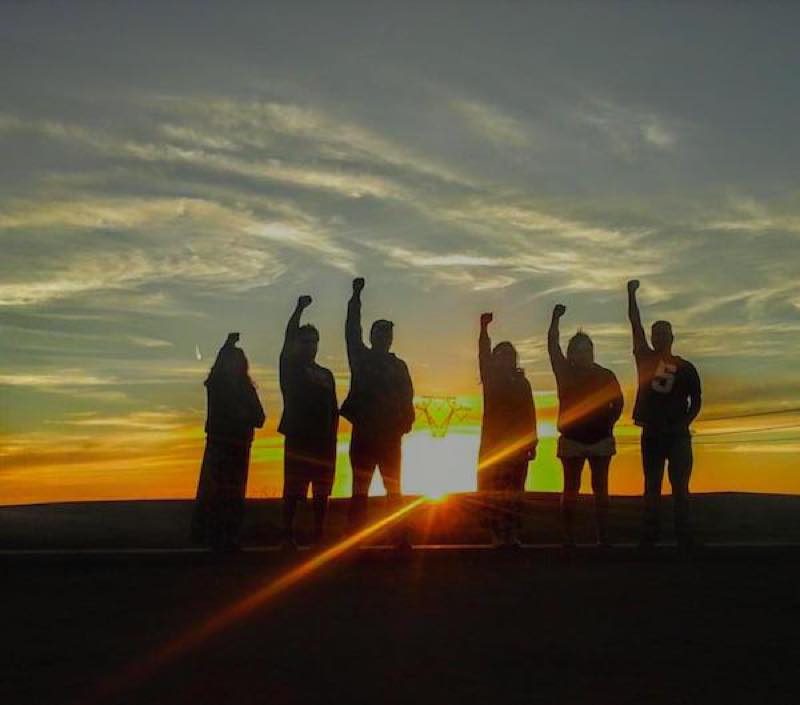
by Deep Green Resistance News Service | Jun 15, 2017 | Lobbying
Featured image by Lucas Reynolds. Judge James Boasberg’s 91-page decision says U.S. Army Corps ‘did not adequately consider’ oil spill impacts; no ruling on whether to keep DAPL operational
The U.S. Army Corps of Engineers violated the law in its fast-tracked approval of the Dakota Access Pipeline (DAPL), a U.S. District Court Judge in Washington D.C. has ruled. Judge James Boasberg said the Corps did not consider key components of the National Environmental Policy Act (NEPA) in granting the Lake Oahe easement under the Missouri River when directed to do so by President Donald Trump shortly after his swearing-in.
The Standing Rock Sioux Tribe, with the Cheyenne River Sioux as interveners, had challenged the approval on the grounds that adequate environmental study had not been conducted. Boasberg agreed on many points, though he did not rule on whether the pipeline should remain operational. It has been carrying oil since June 1.
“Although the Corps substantially complied with NEPA in many areas, the Court agrees that it did not adequately consider the impacts of an oil spill on fishing rights, hunting rights, or environmental justice, or the degree to which the pipeline’s effects are likely to be highly controversial,” Boasberg said in his 91-page decision. “To remedy those violations, the Corps will have to reconsider those sections of its environmental analysis upon remand by the Court. Whether Dakota Access must cease pipeline operations during that remand presents a separate question of the appropriate remedy, which will be the subject of further briefing.”
A status conference will be held next week, according to the environmental law firm EarthJustice, which is representing the tribes in this case. Energy Transfer Partners, the pipeline’s builders, did not respond to requests for comment by press time.
“This is a major victory for the Tribe and we commend the courts for upholding the law and doing the right thing,” said Standing Rock Sioux Chairman Dave Archambault II in a statement. “The previous administration painstakingly considered the impacts of this pipeline and President Trump hastily dismissed these careful environmental considerations in favor of political and personal interests. We applaud the courts for protecting our laws and regulations from undue political influence, and will ask the Court to shut down pipeline operations immediately. ”
The fight over the 1,172-mile-long pipeline that runs hotly contested through four states has been the source of controversy since it was first proposed. The Standing Rock Sioux Tribe became the flashpoint for the issue when thousands of water protectors and hundreds of tribes gathered at camps along the Missouri River over the summer of 2016. They were protesting the routing of the pipeline through treaty lands—especially in light of the fact that it had been rerouted from more affluent Bismarck for the same reason the tribe didn’t want it nearby, because of the danger to drinking water—in a conflict that involved a militarized police force.
“This decision marks an important turning point. Until now, the rights of the Standing Rock Sioux Tribe have been disregarded by the builders of the Dakota Access Pipeline and the Trump Administration—prompting a well-deserved global outcry,” said Earthjustice attorney Jan Hasselman in a statement. “The federal courts have stepped in where our political systems have failed to protect the rights of Native communities.”
by Deep Green Resistance News Service | Dec 16, 2016 | Lobbying, Repression at Home
by Noah Weber
On Sunday, March 7, 1965, roughly 600 African Americans and their allies gathered and marched towards Montgomery, Alabama in order to take a stand and draw attention to the fact that 99% of Selma, Alabama’s registered voters were white, and that the African American community was being denied their legal right to vote. The unarmed men and women who marched across the Edmund Pettus Bridge were met by a heavily armed police force and were tear gassed and beaten horrifically. In the end, 17 marchers were hospitalized, and another 50 were treated for injuries caused by the police.
On Sunday, November 20, 2016, more than 400 Native Americans and their allies marched on the Backwater Bridge outside of Cannon Ball, North Dakota. The Water Protectors had been demonstrating peacefully for months in order to preserve sacred burial grounds and protect their only source of clean drinking water from the oil-bearing Dakota Access Pipeline. However, this unarmed march was meant to clear vehicles that had been set up by DAPL to block the Backwater Bridge. They were attempting to clear the road so that emergency medical vehicles could have faster access to the residents and campers at the Standing Rock Sioux Reservation. After being trapped on the bridge by heavily armed police, the marchers were hosed with water cannons in 23°F temperatures, and shot with rubber bullets, tear gas, pepper spray, and concussion grenades for more than 7 hours. 26 people were hospitalized, and more than 300 were treated for injuries caused by the police forces.
It is highly likely that neither group of marchers knew the full extent of the violence that they were about to experience as they marched on these bridges for the first time. However, they certainly knew what was in store for them for any subsequent actions. After the first march on Montgomery, the nation was horrified by the images broadcast by media sources, and on March 9, more than 2500 people showed up for the second march on Montgomery. Due to a pending decision, and a restraining order issued by Federal District Court Judge Frank Minis Johnson, the marchers turned around on the Pettus Bridge.
Ultimately, on March 17, Judge Johnson ruled that the civil rights activists’ right to march could not be abridged by the state of Alabama, writing “The law is clear that the right to petition one’s government for the redress of grievances may be exercised in large groups…by marching, even along public highways.” Meanwhile, on March 13th, President Lyndon Johnson met with Alabama Governor George Wallace in an attempt to prevent further violence and harassment from being directed at the civil rights activists. While unsuccessful with Wallace, President Johnson introduced a bill two days later to Congress. That bill became the Voting Rights Act. While it took time for the bill to pass, President Johnson deployed 2000 soldiers of the U.S. Army, 1900 Alabama National Guard troops under federal command, and unknown numbers of FBI and Federal Marshals to protect the demonstrators as they successfully continued their march on March 21.
When I showed up on November 24 to bring supplies and provide medical support at the Oceti Sakowin Camp, there were an estimated 3500 people at camp. When I left at the end of the week, there were roughly 10,000. Dozens of countries, and hundreds of tribes from around the world are expressing outrage and concern over the violence and harassment directed towards the Water Protectors at Standing Rock. These communities are also outraged that the pipeline was originally supposed to pass north of Bismarck, ND, but was rejected as being too dangerous to pass near that overwhelmingly white community’s water source, and instead was relocated to pass through traditional Lakota lands and under their Missouri River water source without any conversation regarding indigenous concerns and opposition to the pipeline.
Governor Jack Dalrymple of North Dakota is escalating his rhetoric towards the safety of the people camped at Standing Rock. He has threatened anyone bringing food and clothing donations to the camps with $1000 fines. This week, he threatened to oust the Water Protectors from their camps in the name of safety, due to winter conditions. However, the Water Protectors are not going to leave, and making someone homeless in winter is unconscionable. Using water cannons on peaceful demonstrators in sub-freezing temperatures shows that safety is not Dalrymple’s top priority. Getting people to vacate the land is his priority.
The Water Protectors are going to continue to march, pray, and peacefully demonstrate, regardless of the violent reactions from DAPL security and police forces. They are doing everything that they can to stand up for their rights in a peaceful manner. They are waiting for action from President Obama. It is time for a sit-down between President Obama and Gov. Dalrymple. It is also time for an immediate and decisive response from the Obama administration to ensure the safety of peacefully assembled citizens and their right to clean water. This means troops standing with the Water Protectors, not opposed to them. President Johnson was not perfect, but he has been judged by this nation, and the world, to have been on the correct side of history on civil rights in the wake of Bloody Sunday. Due to the shared history of abuse and denied rights, despite laws and treaties on their side, it is difficult to see why President Obama praises one group’s actions, but has yet to do anything of substance for the other.
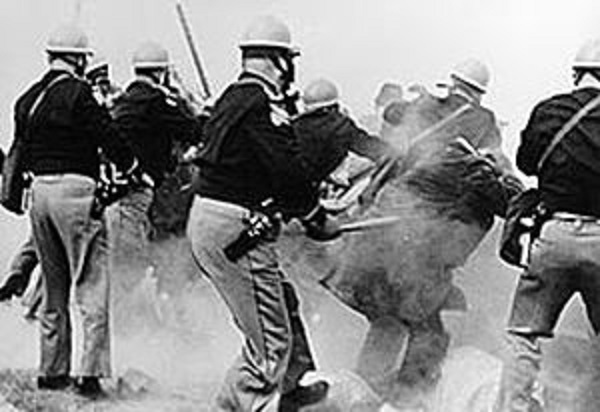
Bloody Sunday
When will troops protect the Water Protectors? So far the only troops acting in such a capacity are the veterans recruited by Wes Clark Jr. My thanks go out to Mr. Clark and his veterans. However, anything short of deploying troops to protect the peacefully assembled demonstrators, in conjunction with pushing a bill through Congress to extend the rights of indigenous communities over the governance of their own land, would be a shameful act by the Obama administration. This is your Pettus Bridge, Mr. President. On which side of this historic bridge do you stand?
Taking the least effective route to enact change is not praiseworthy. A teacher would award a D for such effort.
While the ruling by the Army Corps of Engineers sounds nice, demonstrators are still fighting for Lakota rights on land that is considered to be federally-owned, but was granted to the Lakota “in perpetuity” by the government. The Lakota never relinquished their right to this land. The government took it.
There are still Federal Police and Army Corps vehicles on Lakota land. They are still on the north side of Cantapeta Creek…with the DAPL security forces. I will believe something has changed when Federal forces are standing shoulder-to-shoulder WITH the Standing Rock Water Protectors, indigenous rights have been extended by law, and the pipeline is re-routed or terminated. Until this happens, nothing has changed.
Noah Weber is a nurse and a farmer from Montana. He volunteered as a medic at the Oceti Sakowin Camp at Standing Rock, though most of his time went to ensuring everyone in the medic, healer, midwifery, and warming tents had wood, warmth, and functional stoves.
Featured image: Standing Rock, by Rob Wilson
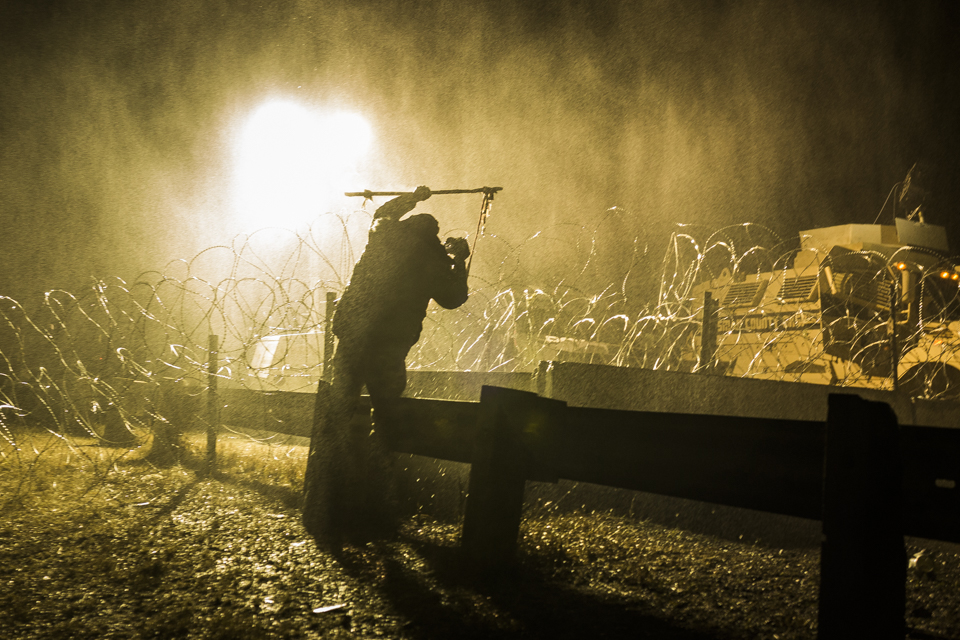
by Deep Green Resistance News Service | Nov 21, 2016 | Obstruction & Occupation, Repression at Home
by Indigenous Environmental Network
Cannon Ball – On November 20th at approximately 6PM CST over 100 Water Protectors from the Oceti Sakowin and Sacred Stone Camps mobilized to a nearby bridge to remove a barricade that was built by the Morton County Sheriff’s Department and the State of North Dakota. This barricade, built after law enforcement raided the 1851 treaty camp, not only restricts North Dakota residents from using the 1806 freely but also puts the community of Cannon Ball, the camps, and the Standing Rock Tribe at risk as emergency services are unable to use that highway.
Water Protectors used a semi-truck to remove two burnt military trucks from the road and were successful at removing one truck from the bridge before police began to attack Water Protectors with tear gas, water canons, mace, rubber bullets, and sound cannons.
At 1:30am CST the Indigenous Rising Media team acquired an update from the Oceti Sakowin Medic team that nearly 200 people were injured, 12 people were hospitalized for head injuries, and one elder went into cardiac arrest at the front lines. At this time, law enforcement was still firing rubber bullets and the water cannon at Water Protectors. About 500 Water protectors gathered at the peak of the non-violent direct action.
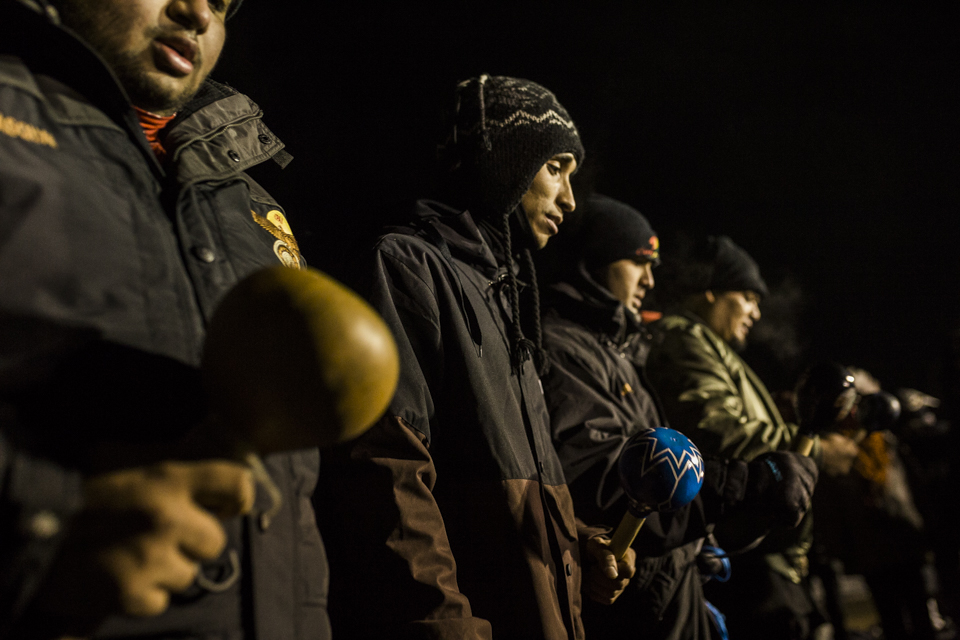
The following is a statement from the Indigenous Environmental Network:
“The North Dakota law enforcement are cowards. Those who are hired to protect citizens attacked peaceful water protectors with water cannons in freezing temperatures and targeted their weapons at people’s faces and heads.
“The Morton County Sheriff’s Department, the North Dakota State Patrol, and the Governor of North Dakota are committing crimes against humanity. They are accomplices with the Dakota Access Pipeline LLC and its parent company Energy Transfer Partners in a conspiracy to protect the corporation’s illegal activities.
“Anyone investing and bankrolling these companies are accomplices. If President Obama does nothing to stop this inhumane treatment of this country’s original inhabitants, he will become an accomplice. And there is no doubt that President Elect Donald Trump is already an accomplice as he is invested in DAPL”.








